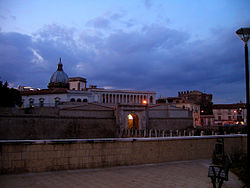Ancient Capua
| Capua | ||
|---|---|---|
| Comune | ||
| Comune di Capua | ||
 |
||
|
||
| Location of Capua in Italy | ||
| Coordinates: 41°06′20″N 14°12′50″E / 41.10556°N 14.21389°E | ||
| Country | Italy | |
| Region | Campania | |
| Province / Metropolitan city | Caserta (CE) | |
| Frazioni | Sant'Angelo in Formis | |
| Government | ||
| • Mayor | Eduardo Centore | |
| Area | ||
| • Total | 48.63 km2 (18.78 sq mi) | |
| Elevation | 25 m (82 ft) | |
| Population (30 November 2015) | ||
| • Total | 18,802 | |
| • Density | 390/km2 (1,000/sq mi) | |
| Demonym(s) | Capuani | |
| Time zone | CET (UTC+1) | |
| • Summer (DST) | CEST (UTC+2) | |
| Postal code | 81043 | |
| Dialing code | 0823 | |
| Patron saint | St. Agatha | |
| Saint day | 5 February | |
| Website | Official website | |
Capua is a city and comune in the province of Caserta, Campania, southern Italy, situated 25 km (16 mi) north of Naples, on the northeastern edge of the Campanian plain. Ancient Capua was situated where Santa Maria Capua Vetere is now.
The name of Capua comes from the Etruscan Capeva. The meaning is 'City of Marshes'. Its foundation is attributed by Cato the Elder to the Etruscans, and the date given as about 260 years before it was "taken" by Rome. If this is true it refers not to its capture in the Second Punic War (211 BC) but to its submission to Rome in 338 BC, placing the date of foundation at about 600 BC, while Etruscan power was at its highest. In the area several settlements of the Villanovian civilization were present in prehistoric times, and these were probably enlarged by the Oscans and subsequently by the Etruscans.
Etruscan supremacy in Campania came to an end with the Samnite invasion in the latter half of the 5th century BC.
About 424 BC it was captured by the Samnites and in 343 BC besought Roman help against its conquerors. Capua entered into alliance with Rome for protection against the Samnite mountain tribes, along with its dependent communities Casilinum, Calatia, Atella, so that the greater part of Campania now fell under Roman supremacy. The citizens of Capua received the civitas sine suffragio (citizenship without the vote).
In the second Samnite War with Rome, Capua proved an untrustworthy Roman ally, so that after the defeat of the Samnites, the Ager Falernus on the right bank of the Volturnus was confiscated. In 318 BC the powers of the native officials (meddices) were limited by the appointment of officials with the title praefecti Capuam Cumas (taking their name from the most important towns of Campania); these were at first mere deputies of the praetor urbanus, but after 123 BC were elected Roman magistrates, four in number; they governed the whole of Campania until the time of Augustus, when they were abolished. It was the capital of Campania Felix.
...
Wikipedia


